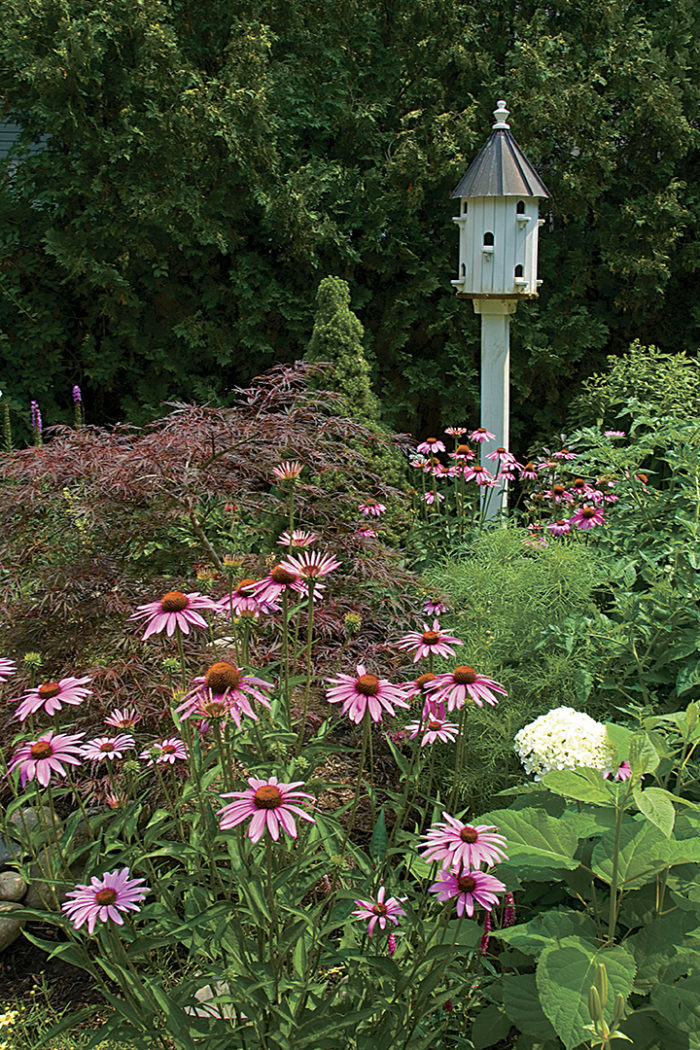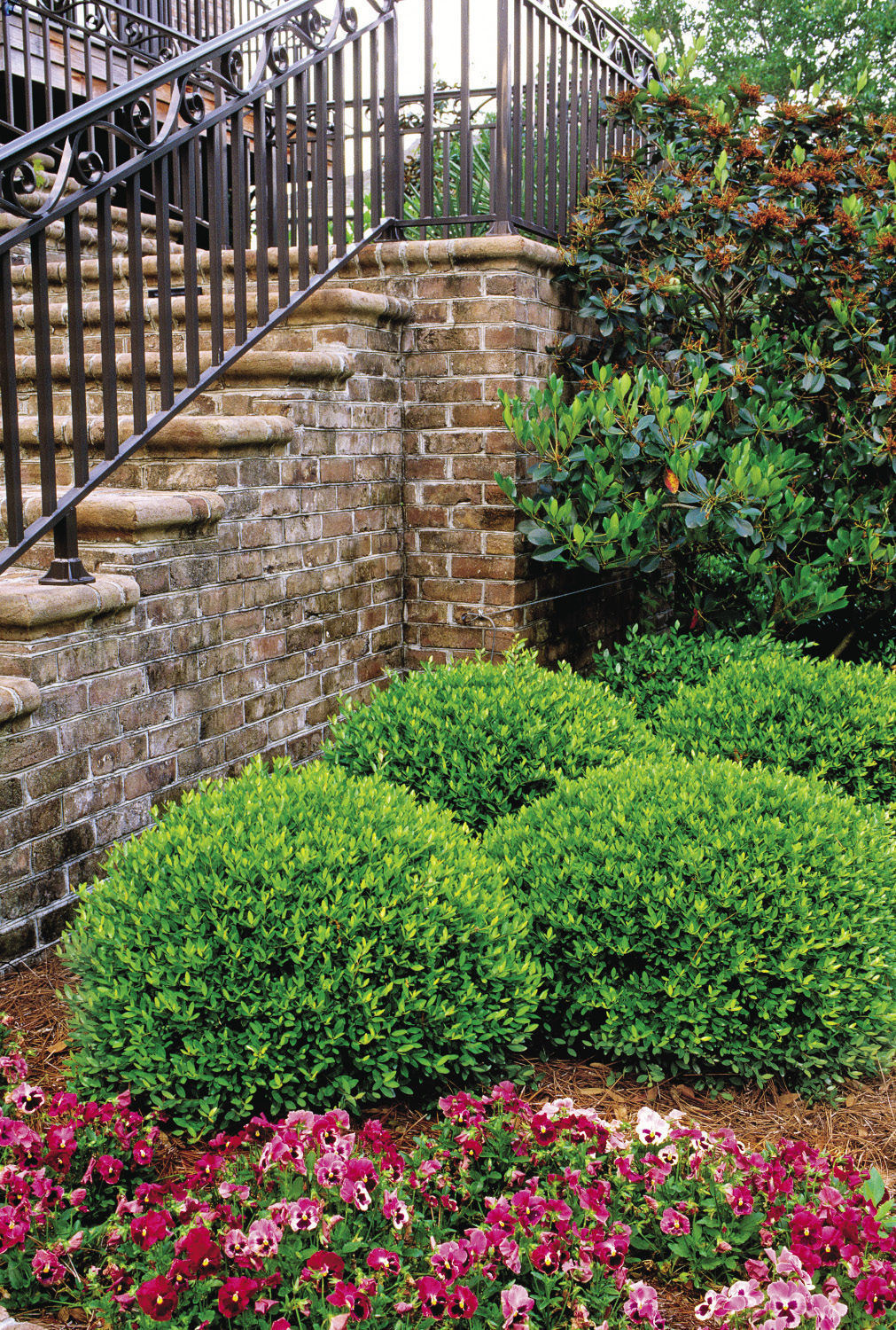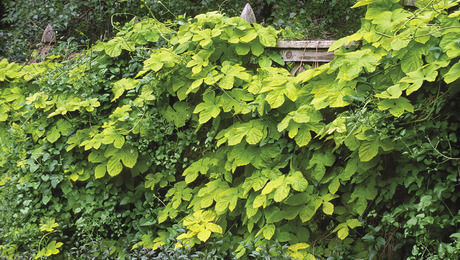
Gardeners, especially plant collectors like me, often unknowingly create a common problem in their gardens: too many flashy focal-point plants all vying for attention. An overabundance of strong colors, textures, and shapes crammed together in one bed is the equivalent of a concert with too many divas fighting for center stage.
As with strong singers, strong plants need backup to pull everything together. Look at your garden from a new angle, and think about how to incorporate ground covers, perennials, and shrubs that support—rather than compete with—your garden divas.
Support plants are indispensable for highlighting focal points and creating harmony as well as for filling in gaps between seasons and adding winter greenery. To harmonize your garden, consider adding some of these reliable support plants.
Juniper can Soften any Space, in Nearly Any Zone

Name: Juniperus spp. and cvs.
From backdrop to ground cover, juniper is the botanical equivalent of fabric softener: smoothing the hardest edges in your garden and supporting the strong players without competing with them. Best of all, there is an option for nearly any zone and soil type; all varieties require little water once established. Foliage comes in shades of green, silvery blue, and yellow.
Low, spreading types, such as creeping juniper (J. horizontalis, Zones 3–9), are best used as a ground cover or as trailing over the edges of walls. Taller, spreading varieties are great for softening and anchoring the base of flowering shrubs. Chinese juniper (J. chinensis, Zones 3–9; ‘Saybrook Gold’, pictured) and Pfitzer juniper (J. pfitzeriana, Zones 4–9) are excellent support plants. There are countless cultivars and selections of both that range from 1 foot to several feet tall, with arching and layered branching; so make sure you choose one with a mature height that fits your space.
USDA Hardiness Zones: 2 to 9
Size: 1 to 20 feet tall and wide
Conditions: Full sun; well-drained soil
Purple Chinese Fringe Flower Handles Jobs Big and Small

Name: Loropetalum chinense var. rubrum and cvs.
A few short years ago, no one had ever heard of purple Chinese fringe flower, but it’s now a garden staple. The semievergreen burgundy foliage is a natural for foundation or support plantings. Prune it into a hedge, or let it grow naturally into an arching vase shape. Although it has become popular to shear this shrub like a boxwood, I prefer to let it grow naturally, with only occasional hand pruning of the long shoots to keep the plant inbounds.
To avoid excessive maintenance, choose a variety that fits your application. My favorites for tall hedges, screening, or garden walls are ‘Zhuzhou Fuchsia’ (pictured) and ‘Pizazz’. Dwarf selections, such as ‘Ruby’, ‘Plum Delight’ or ‘Purple Diamond’, are best for shorter applications. ‘Purple Diamond’ is especially nice, with its burgundy-colored foliage on both sides of the leaf. If you are searching for a support plant that gets only 1 to 2 feet tall, then ‘Purple Pixie’ is perfect for you. It has a cascading growth habit—just right for growing over retaining walls, cascading out of containers, or spreading over the ground.
Zones: 7 to 9
Size: 2 to 12 feet tall and 4 to 8 feet wide
Conditions: Full sun to partial shade; acidic, moist, well-drained soil
Purple Coneflower Provides Support with Color

Name: Echinacea purpurea and cvs.
A long bloom season, fast growth, attractive flowers, and easy care have guaranteed purple coneflower a place as one of the best support plants for perennial borders. No full-sun border would be complete without it. This perennial was historically available in only a few varieties, but recent breeding has produced cultivars in every shade of red, purple, white, pink, orange, and yellow.
I prefer masses of the purple, pink, and white varieties, such as ‘Kim’s Knee High’, ‘Fragrant Angel’, and ‘Pink Double Delight’ (pictured) for backdrop and support purposes. Their soft colors and classic daisy shape tone down the brighter colors and bolder textures of garden divas. White varieties also work well as a spotlight in the garden, drawing attention to specific areas.
Zones: 3 to 9
Size: 2 to 3 feet tall and wide
Conditions: Full sun; average, well-drained soil
Holly Ties It All Together

Name: Ilex spp. and cvs.
Holly is the first plant that should be added to a garden. A go-to hedge plant, it helps build walls, borders, edges, and frames. When situated in small groups around vibrant focal points, holly makes an admirable support plant. The dark evergreen foliage also works well as a winter fill-in behind deciduous flowering shrubs and perennials. And with a firm background of dark holly, any number of garden divas can fight for center stage and still not overwhelm a scene.
Some of my favorite holly cultivars belong to the Red Holly Hybrid series, bred from the proven standby ‘Mary Nell’ (I. ‘Mary Nell’, Zones 6–9). For a hedged garden wall, I prefer Acadiana™ (I. ‘Magiana’, Zones 6–9). It has a tight habit with deep red new growth and heavy berry set. Unpruned, it will reach 14 feet tall and 8 feet wide. Robin™ (I. ‘Conin’, Zones 6–9) is perfect for creating screening. It has striking maroon new growth that changes to dark green, followed by deep red berries. Left alone, it will grow into a natural pyramidal shape reaching 14 feet tall. For edging a bed or hiding a foundation, try a soft-textured, shorter holly, such as dwarf yaupon holly (I. vomitoria ‘Nana’, Zones 7–11, photo, right).
Zones: 5 to 9
Size: 1 to 14 feet tall and 1 to 8 feet wide
Conditions: Full sun to full shade; slightly acidic, organic-rich, well-drained soil
Lilyturf Brightens Shady Beds Year-Round

Name: Liriope muscari and cvs.
Few gardeners are unaware of this small support plant’s multiple talents. The evergreen foliage is ideal for framing annual borders and perennial beds. It softens shady areas under large trees as well as harsh hardscapes and walkways, while also providing a lush backdrop for bolder plants.
Lilyturf is often grouped, unfortunately, into two basic types: green and variegated. There are new cultivars, however, that are worth seeking out. These varieties offer more cold tolerance, better flower power, and an increased ability to handle sun than the straight species. One of my favorites is Marc Anthony® (L. muscari ‘Marant’, Zones 6–10, pictured), which has green-and-white-variegated leaves that don’t mind full sun; this cultivar also has attractive lavender flowers on pink stalks. To brighten a shady garden path or to spotlight an accent plant, try ‘Monroe White’ for its pure white flower spikes. It’s exceptionally low maintenance—all it needs is a yearly haircut in late winter or early spring to remove tattered old foliage.
(Note: Beware of L. spicata (Zones 6–10), the lilyturf that many have grown to hate. Unlike members of the L. muscari group, this species spreads quickly to the point of being invasive.)
Zones: 6 to 10
Size: 1 foot tall and 1 to 2 feet wide
Conditions: Full sun to partial shade; average, well-drained soil
Asian Jasmine Conceals Unsightly Spots

Name: Trachelospermum asiaticum and cvs.
Even the strongest, most discordant plant will mesh with its surroundings when standing among a swath of Asian jasmine. It not only helps bold plants fit in but also hides a multitude of garden sins. This ground cover will come to your rescue, filling in areas of bare dirt or hiding the fading foliage of seasonal showstoppers, such as daffodils (Narcissus cvs., Zones 3–9) or other bulbs.
Asian jasmine works hard to make your garden look good, but it does need an occasional trim to keep it within bounds. Set the limits on how far you want it to spread, and mow or cut it back at least once a year during the growing season.
Be careful about stepping beyond the standard Asian jasmine, however, because some newer, more colorful cultivars can quickly turn into divas themselves. The best Asian jasmines to use as a backdrop are the deep green species (pictured) or the green-and-white-variegated forms, such as ‘Variegata’. For simple variegation with a little something extra, try variegated ‘Winter Beauty’, which has pink-tinged leaves in cool weather.
Zones: 7 to 11
Size: Up to 1 foot tall and spreading to 6 feet or more
Conditions: Full sun to partial shade; fertile, well-drained soil
Japanese Plum Yew Withstands Heat and Deer Better than Other Yews

Name: Cephalotaxus harringtonii and cvs.
For southern gardeners who pine for Hick’s yew (Taxus media ‘Hicksii’, Zones 5–7), there is finally a substitute: Japanese plum yew. This native of Japan and Korea handles heat and humidity much better than other yews. In cool climates, it can survive full sun, but in warmer areas, confine it to spots with afternoon full shade.
The most common variety, ‘Prostrata’, has low-mounding foliage that reaches 2 to 3 feet tall and wide. It’s ideal for hiding sharp edges of hardscapes or creating a background for shade perennials or annuals, looking its best massed along a foundation. It also works well cascading over the side of large shade containers.
‘Fastigiata’ has an upright, vase-shaped growth habit. It can reach 10 feet tall and 6 to 8 feet wide, but I prefer to keep it hedged to 3 to 4 feet tall and wide in the garden. This form is great as a backdrop for lightly shaded borders, acting like a curtain behind bolder plants. If planted singly, this plum yew behaves as an accent plant. It is also deerproof.
My favorite cultivar is Yewtopia™ (pictured), with its soft, needled foliage that can be hedged or grown naturally to 3 to 4 feet tall and wide. It balances out even the loudest garden divas.
Zones: 6 to 9
Size: 2 to 10 feet tall and wide
Conditions: Full sun to full shade; moist, sandy, well-drained soil
Japanese Sacred Lily Keeps the Garden Alive in Winter

Name: Rohdea japonica and cvs.
Like a quietly singing choir, Japanese sacred lily works in the background to soften those garden divas growing in the shadiest of beds. Strap-shaped, deep green leaves form upright vase-shaped clumps, which slowly spread outward. Red berries often appear in late fall, though the flowers are seldom noticed.
If your shade garden lacks greenery in winter, plant sweeps or repeat clumps of Japanese sacred lily (‘Mure-suzume’, pictured) in the garden. This plant also works wonders as a screen, hiding less attractive garden necessities, such as irrigation-control boxes and unsightly edging. Japanese sacred lily can be relatively expensive due to its slow rate of propagation, but it will reward you with years of reliable performance.
Zones: 7 to 9
Size: 1 to 2 feet tall and wide
Conditions: Partial to full shade; average to moist, well-drained soil
Plant with Purpose

Your garden should be built on a solid foundation of support plants. My rule of thumb is to plant at least 50 percent supporting greenery. This is the minimum to keep your garden from turning into a clash of conflicting voices. Support plants may not be sexy, but you’ll never have a hard time finding them at your local nursery. They are the building blocks upon which almost all great gardens are built. Keep two points in mind when choosing and planting your support plants.
Support plants work best in groups of three or more.
Just as backup singers highlight the lead singer, using more than one plant helps frame the brighter plants in a garden.
Green isn’t as dull as you might think.
Don’t be tempted by new cultivars with flashy variegation or colored sports—they will only add to the cacophony of your garden. Green goes with everything.
Jimmy Turner is senior director of gardens at the Dallas Arboretum in Dallas, Texas.
Photos: Jerry Pavia; Judy White/www.gardenphotos.com; Michelle Gervais; Botanic Images, Inc./www.gardenworldimages.com; Plant Development Services, Inc.
Sources
The following mail-order plant sellers offer the widest selection of the plants featured:
Forestfarm, Williams, Ore.; 541-846-7269; www.forestfarm.com
Lazy S’S Farm Nursery, 2360 Spotswood Trail, Barboursville, VA 22923; www.lazyssfarm.com
Plantsbymail.com, PO Box 365, Loxley, AL 36551; www.plantsbymail.com
Sooner Plant Farm, Park Hill, Okla.; 918-453-0771; www.soonerplantfarm.com


















Comments
Log in or create an account to post a comment.
Sign up Log in